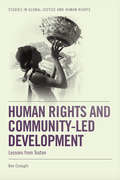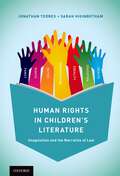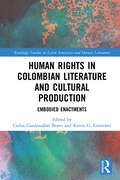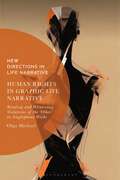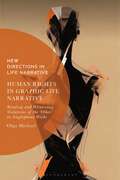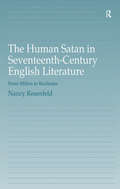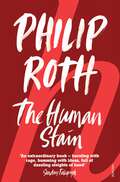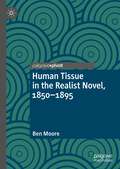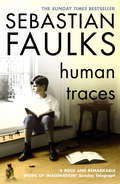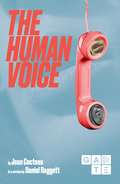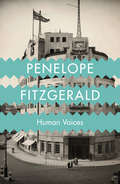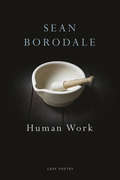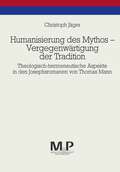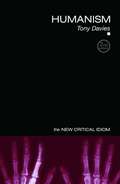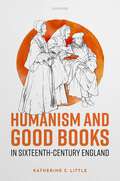- Table View
- List View
Human Rights and Community-led Development: Lessons from Tostan (Studies In Global Justice And Human Rights Ser.)
by Ben CislaghiProvides cross-disciplinary perspectives on the study of animals in humanities
Human Rights and Community-led Development: Lessons from Tostan
by Ben CislaghiExamines the influence of classical philosophy on revenge narratives by Shakespeare and his contemporaries
Human Rights and Literature: Writing Rights
by Pramod K. NayarSet at the intersection of Human Rights, social justice and Literature, this cutting edge book examines a range of literary texts, fiction, plays and poetry, and through them considers representations of Human Rights and their violations. Examining violated bodies and subjects, the settings and environments in which these are embedded and the witnessing of atrocities, it considers how the ‘subject’ (or ‘person’ of Human Rights) emerges within fiction or poetry. Structured so as to move outward from the individual body to the world, the study progresses from the preconditions or settings for Human Rights violations through to atrocity, from witnessing to the making of a specific kind of public around traumatic recall. It addresses representations of destroyed corporeality and subjectivity, the violations and dissolution of the subject and the construction of trauma-memory citizenship to the making of communities of mourning. Through a broad study of texts from different genres, this text reveals how Literature both documents the basic human aspirations of happiness, security and hope, but also the limitations and the violations of these aspirations.
Human Rights and Narrated Lives: The Ethics of Recognition
by K. Schaffer S. SmithPersonal narratives have become one of the most potent vehicles for advancing human rights claims across the world. These two contemporary domains, personal narrative and human rights, literature and international politics, are commonly understood to operate on separate planes. This study however, examines the ways these intersecting realms unfold and are enfolded in one another in ways both productive of and problematic for the achievement of social justice. Human Rights and Narrated Lives explores what happens when autobiographical narratives are produced, received, and circulated in the field of human rights. It asks how personal narratives emerge in local settings; how international rights discourse enables and constrains individual and collective subjectivities in narration; how personal narratives circulate and take on new meanings in new contexts; and how and under what conditions they feed into, affect, and are affected by the reorganizations of politics in the post cold war, postcolonial, globalizing human rights contexts. To explore these intersections, the authors attend the production, circulation, reception, and affective currents of stories in action across local, national, transnational, and global arenas. They do so by looking at five case studies: in the context of the Truth and Reconciliation processes in South Africa; the National Inquiry into the Forced Removal of Indigenous Children from their Families in Australia; activism on behalf of former 'comfort women' from South/East Asia; U.S. prison activism; and democratic reforms in the aftermath of the Tiananmen Square Massacre in China.
The Human Rights Graphic Novel: Drawing it Just Right
by Pramod K. NayarThis book studies human rights discourse across a variety of graphic novels, both fiction and non-fiction, originating in different parts of the world, from India to South Africa, Sarajevo to Vietnam, with texts on the Holocaust, the Partition of the Indian subcontinent, the Rwandan and Sarajevan genocides, the Vietnam War, comfort women in World War II and the Civil Rights movement in the USA, to mention a few. The book demonstrates the emergence of the ‘universal’ subject of human rights, despite the variations in contexts. It shows how war, rape, genocide, abuse, social iniquity, caste and race erode personhood in multiple ways in the graphic novel, which portrays the construction of vulnerable subjects, the cultural trauma of collectives, the crisis and necessity of witnessing, and resilience-resistance through specific representational and aesthetic strategies. It covers a large number of authors and artists: Joe Sacco, Joe Kubert, Matt Johnson-Walter Pleece, Guy Delisle, Appupen, Thi Bui, Olivier Kugler and others. Through a study of these vastly different authors and styles, the book proposes that the graphic novel as a form is perfectly suited to the ‘culture’ and the lingua franca of human rights due to its amenability to experimentation and the sheer range within the form. The book will appeal to scholars in comics studies, human rights studies, visual culture studies and to the general reader with an interest in these fields.
The Human Rights Graphic Novel: Drawing it Just Right
by Pramod K. NayarThis book studies human rights discourse across a variety of graphic novels, both fiction and non-fiction, originating in different parts of the world, from India to South Africa, Sarajevo to Vietnam, with texts on the Holocaust, the Partition of the Indian subcontinent, the Rwandan and Sarajevan genocides, the Vietnam War, comfort women in World War II and the Civil Rights movement in the USA, to mention a few. The book demonstrates the emergence of the ‘universal’ subject of human rights, despite the variations in contexts. It shows how war, rape, genocide, abuse, social iniquity, caste and race erode personhood in multiple ways in the graphic novel, which portrays the construction of vulnerable subjects, the cultural trauma of collectives, the crisis and necessity of witnessing, and resilience-resistance through specific representational and aesthetic strategies. It covers a large number of authors and artists: Joe Sacco, Joe Kubert, Matt Johnson-Walter Pleece, Guy Delisle, Appupen, Thi Bui, Olivier Kugler and others. Through a study of these vastly different authors and styles, the book proposes that the graphic novel as a form is perfectly suited to the ‘culture’ and the lingua franca of human rights due to its amenability to experimentation and the sheer range within the form. The book will appeal to scholars in comics studies, human rights studies, visual culture studies and to the general reader with an interest in these fields.
Human Rights in Children's Literature: Imagination and the Narrative of Law
by Jonathan Todres Sarah HiginbothamHow can children grow to realize their inherent rights and respect the rights of others? In this book, authors Jonathan Todres and Sarah Higinbotham explore this question through both human rights law and children's literature. Both international and domestic law affirm that children have rights, but how are these norms disseminated so that they make a difference in children's lives? Human rights education research demonstrates that when children learn about human rights, they exhibit greater self-esteem and respect the rights of others. The Convention on the Rights of the Child -- the most widely-ratified human rights treaty -- not only ensures that children have rights, it also requires that states make those rights "widely known, by appropriate and active means, to adults and children alike." This first-of-its-kind requirement for a human rights treaty indicates that if rights are to be meaningful to the lives of children, then government and civil society must engage with those rights in ways that are relevant to children. Human Rights in Children's Literature investigates children's rights under international law -- identity and family rights, the right to be heard, the right to be free from discrimination, and other civil, political, economic, social and cultural rights -- and considers the way in which those rights are embedded in children's literature from Peter Rabbit to Horton Hears a Who! to Harry Potter. This book traverses children's rights law, literary theory, and human rights education to argue that in order for children to fully realize their human rights, they first have to imagine and understand them.
Human Rights in Children's Literature: Imagination and the Narrative of Law
by Jonathan Todres Sarah HiginbothamHow can children grow to realize their inherent rights and respect the rights of others? In this book, authors Jonathan Todres and Sarah Higinbotham explore this question through both human rights law and children's literature. Both international and domestic law affirm that children have rights, but how are these norms disseminated so that they make a difference in children's lives? Human rights education research demonstrates that when children learn about human rights, they exhibit greater self-esteem and respect the rights of others. The Convention on the Rights of the Child -- the most widely-ratified human rights treaty -- not only ensures that children have rights, it also requires that states make those rights "widely known, by appropriate and active means, to adults and children alike." This first-of-its-kind requirement for a human rights treaty indicates that if rights are to be meaningful to the lives of children, then government and civil society must engage with those rights in ways that are relevant to children. Human Rights in Children's Literature investigates children's rights under international law -- identity and family rights, the right to be heard, the right to be free from discrimination, and other civil, political, economic, social and cultural rights -- and considers the way in which those rights are embedded in children's literature from Peter Rabbit to Horton Hears a Who! to Harry Potter. This book traverses children's rights law, literary theory, and human rights education to argue that in order for children to fully realize their human rights, they first have to imagine and understand them.
Human Rights in Colombian Literature and Cultural Production: Embodied Enactments (Routledge Studies in Latin American and Iberian Literature)
by Carlos Gardeazábal BravoThis volume explores how Colombian novelists, artists, performers, activists, musicians, and others seek to enact—to perform, to stage, to represent—human rights situations that are otherwise enacted discursively, that is, made public or official, in juridical and political realms in which justice often remains an illusory or promised future. In order to probe how cultural production embodies the tensions between the abstract universality of human rights and the materiality of violations on individual human bodies and on determined groups, the volume asks the following questions: How does the transmission of historical traumas of Colombia’s past, through human rights narratives in various forms, inform the debates around the subjects of rights, truth and memory, remembrance and forgetting, and the construction of citizenship through solidarity and collective struggles for justice? What are the different roles taken by cultural products in the interstices among rights, laws, and social justice within different contexts of state violence and states of exception? What are alternative perspectives, sources, and (micro)histories from Colombia of the creation, evolution, and practice of human rights? How does the human rights discourse interface with notions of environmental justice, especially in the face of global climate change, regional (neo)extractivism, the implementation of megaprojects, and ongoing post-accord thefts and (re)appropriations of land? Through a wide range of disciplinary lenses, the different chapters explore counter-hegemonic concepts of human rights, decolonial options struggling against oppression and market logic, and alternative discourses of human dignity and emancipation within the pluriverse.
Human Rights in Colombian Literature and Cultural Production: Embodied Enactments (Routledge Studies in Latin American and Iberian Literature)
by Carlos Gardeazábal Bravo Kevin G. GuerrieriThis volume explores how Colombian novelists, artists, performers, activists, musicians, and others seek to enact—to perform, to stage, to represent—human rights situations that are otherwise enacted discursively, that is, made public or official, in juridical and political realms in which justice often remains an illusory or promised future. In order to probe how cultural production embodies the tensions between the abstract universality of human rights and the materiality of violations on individual human bodies and on determined groups, the volume asks the following questions: How does the transmission of historical traumas of Colombia’s past, through human rights narratives in various forms, inform the debates around the subjects of rights, truth and memory, remembrance and forgetting, and the construction of citizenship through solidarity and collective struggles for justice? What are the different roles taken by cultural products in the interstices among rights, laws, and social justice within different contexts of state violence and states of exception? What are alternative perspectives, sources, and (micro)histories from Colombia of the creation, evolution, and practice of human rights? How does the human rights discourse interface with notions of environmental justice, especially in the face of global climate change, regional (neo)extractivism, the implementation of megaprojects, and ongoing post-accord thefts and (re)appropriations of land? Through a wide range of disciplinary lenses, the different chapters explore counter-hegemonic concepts of human rights, decolonial options struggling against oppression and market logic, and alternative discourses of human dignity and emancipation within the pluriverse.
Human Rights in Graphic Life Narrative: Reading and Witnessing Violations of the 'Other' in Anglophone Works (New Directions in Life Narrative)
by Dr Olga MichaelSurveying print and digital graphic life narratives about people who become 'othered' within Western contexts, this book investigates how comics and graphic novels witness human rights transgressions in contemporary Anglophone culture and how they can promote social justice. With thought given to how the graphic form can offer a powerful counterpoint to the legal, humanitarian and media discourses that dehumanise the most violated and dispossessed, but also how these works may unconsciously reproduce Western neo-colonial presentations of the 'other,' Olga Michael focuses on gender, death, space, and border violence within graphic life narratives depicting suffering across different geo- and biopolitical locations. Combining the familiar with the lesser-known, this book covers works by artists such as Joe Sacco, Thi Bui, Mia Kirshner, Phoebe Gloeckner, Kamel Khélif, Francesca Sanna, Gabi Froden, Benjamin Dix and Lindsay Pollock, as well as Safdar Ahmed and Ali Dorani/Eaten Fish. Interdisciplinary in its consideration of life writing, comics and human rights studies, and comparative in approach, this book explores such topics as the aesthetics of visualised suffering; spatial articulations of human rights violations; the occurrence of violations whilst crossing borders; the gendered dimensions of visually captured violence; and how human rights discourses intersect with graphic depictions of the dead. In so doing, Michael establishes how to read human rights and social justice comics in relation to an escalating global crisis and deftly complicates negotiations of 'otherness.' A vitally important work to the humanities sector, this book underscores the significance of postcolonial decolonized reading acts as forms of secondary witness.
Human Rights in Graphic Life Narrative: Reading and Witnessing Violations of the 'Other' in Anglophone Works (New Directions in Life Narrative)
by Dr Olga MichaelSurveying print and digital graphic life narratives about people who become 'othered' within Western contexts, this book investigates how comics and graphic novels witness human rights transgressions in contemporary Anglophone culture and how they can promote social justice. With thought given to how the graphic form can offer a powerful counterpoint to the legal, humanitarian and media discourses that dehumanise the most violated and dispossessed, but also how these works may unconsciously reproduce Western neo-colonial presentations of the 'other,' Olga Michael focuses on gender, death, space, and border violence within graphic life narratives depicting suffering across different geo- and biopolitical locations. Combining the familiar with the lesser-known, this book covers works by artists such as Joe Sacco, Thi Bui, Mia Kirshner, Phoebe Gloeckner, Kamel Khélif, Francesca Sanna, Gabi Froden, Benjamin Dix and Lindsay Pollock, as well as Safdar Ahmed and Ali Dorani/Eaten Fish. Interdisciplinary in its consideration of life writing, comics and human rights studies, and comparative in approach, this book explores such topics as the aesthetics of visualised suffering; spatial articulations of human rights violations; the occurrence of violations whilst crossing borders; the gendered dimensions of visually captured violence; and how human rights discourses intersect with graphic depictions of the dead. In so doing, Michael establishes how to read human rights and social justice comics in relation to an escalating global crisis and deftly complicates negotiations of 'otherness.' A vitally important work to the humanities sector, this book underscores the significance of postcolonial decolonized reading acts as forms of secondary witness.
The Human Satan in Seventeenth-Century English Literature: From Milton to Rochester
by Nancy RosenfeldFramed by an understanding that the very concept of what defines the human is often influenced by Renaissance and early modern texts, this book establishes the beginning of the literary development of the satanic form into a humanized form in the seventeenth century. This development is centered on characters and poetry of four seventeenth-century writers: the Satan character in John Milton's Paradise Lost and Paradise Regained, the Tempter in John Bunyan's Grace Abounding to the Chief of Sinners and Diabolus in Bunyan's The Holy War, the poetry of John Wilmot, earl of Rochester, and Dorimant in George Etherege's Man of Mode. The initial understanding of this development is through a sequential reading of Milton and Bunyan which examines the Satan character as an archetype-in-the-making, building upon each to work so that the character metamorphoses from a groveling serpent and fallen archangel to a humanized form embodying the human impulses necessary to commit evil. Rosenfeld then argues that this development continues in Restoration literature, showing that both Rochester and Etherege build upon their literary predecessors to develop the satanic figure towards greater humanity. Ultimately she demonstrates that these writers, taken collectively, have imbued Satan with the characteristics that define the human. This book includes as an epilogue a discussion of Samson in Milton's Samson Agonistes as a later seventeenth-century avatar of the humanized satanic form, providing an example for understanding a stock literary character in the light of early modern texts.
The Human Satan in Seventeenth-Century English Literature: From Milton to Rochester
by Nancy RosenfeldFramed by an understanding that the very concept of what defines the human is often influenced by Renaissance and early modern texts, this book establishes the beginning of the literary development of the satanic form into a humanized form in the seventeenth century. This development is centered on characters and poetry of four seventeenth-century writers: the Satan character in John Milton's Paradise Lost and Paradise Regained, the Tempter in John Bunyan's Grace Abounding to the Chief of Sinners and Diabolus in Bunyan's The Holy War, the poetry of John Wilmot, earl of Rochester, and Dorimant in George Etherege's Man of Mode. The initial understanding of this development is through a sequential reading of Milton and Bunyan which examines the Satan character as an archetype-in-the-making, building upon each to work so that the character metamorphoses from a groveling serpent and fallen archangel to a humanized form embodying the human impulses necessary to commit evil. Rosenfeld then argues that this development continues in Restoration literature, showing that both Rochester and Etherege build upon their literary predecessors to develop the satanic figure towards greater humanity. Ultimately she demonstrates that these writers, taken collectively, have imbued Satan with the characteristics that define the human. This book includes as an epilogue a discussion of Samson in Milton's Samson Agonistes as a later seventeenth-century avatar of the humanized satanic form, providing an example for understanding a stock literary character in the light of early modern texts.
The Human Stain: Philip Roth's Novel The Human Stain (American Trilogy Ser. #3)
by Philip Roth'An extraordinary book - bursting with rage, humming with ideas, full of dazzling sleights of hand'- Sunday TelegraphPhilip Roth's brilliant conclusion to his eloquent trilogy of post-war America - a magnificent successor to American Pastoral and I Married a CommunistIt is 1998, the year America is plunged into a frenzy of prurience by the impeachment of a president, and in a small New England town a distinguished classics professor, Coleman Silk, is forced to retire when his colleagues allege that he is a racist. The charge is unfounded, the persecution needless, but the truth about Silk would astonish even his most virulent accuser. Coleman Silk has a secret, one which has been kept for fifty years from his wife, his four children, his colleagues, and his friends, including the writer Nathan Zuckerman. It is Zuckerman who comes upon Silk's secret, and sets out to unearth his former buried life, piecing the biographical fragments back together. This is against backdrop of seismic shifts in American history, which take on real, human urgency as Zuckerman discovers more and more about Silk's past and his futile search for renewal and regeneration.________________PRAISE FOR THE HUMAN STAIN:'One of the most beautiful books I've ever read' Red'[A] tender, shocking and incendiary story on the failure of the American dream refracted through the prism of race' Guardian'A masterpiece' Mail on Sunday
Human Tissue in the Realist Novel, 1850-1895 (Palgrave Studies in Literature, Science and Medicine)
by Ben MooreThis Pivot engages with current debates about anthropocentrism and the Anthropocene to propose a reappraisal of the realist novel in the second half of the nineteenth century. Through three case studies, it argues for ‘human tissue’ as a conceptual tool for reading that brings together biology, literature and questions of layering. This new approach is shown to be especially salient to the Victorian period, when the application of ‘tissue’ to biology first emerges. The book is distinctive in bringing together theoretical concerns around realism and the Anthropocene – two major topics in literary criticism – and presenting a new methodology to approach this conjunction, demonstrated through original readings of Charles Kingsley, George Eliot, and Emile Zola and two English-language writers he influenced (George Moore and Vernon Lee).
Human Traces: Human Traces Poster
by Sebastian FaulksAs young boys both Jacques Rebière and Thomas Midwinter become fascinated with trying to understand the human mind. As psychiatrists, their quest takes them from the squalor of the Victorian lunatic asylum to the crowded lecture halls of the renowned Professor Charcot in Paris; from the heights of the Sierra Madre in California to the plains of unexplored Africa. As the concerns of the old century fade and the First World War divides Europe, the two men's volatile relationship develops and changes, but is always tempered by one exceptional woman; Thomas's sister Sonia.Moving and challenging in equal measure, Human Traces explores the question of what kind of beings men and women really are.
Human Traces: The Sunday Times Bestseller
by Sebastian FaulksTHE SUNDAY TIMES BESTSELLER'Shocking and enlightening... touching and affecting' DAILY MAIL'A masterpiece . . . one of the great novels of this or any other century' INDEPENDENTAs young boys, both Jacques Rebière and Thomas Midwinter become fascinated with trying to understand the human mind. As psychiatrists, their quest takes them from the squalor of the Victorian lunatic asylum to the crowded lecture halls of the renowned Professor Charcot in Paris; from the heights of the Sierra Madre in California to the plains of unexplored Africa.As the concerns of the old century fade and the First World War divides Europe, the two men's volatile relationship develops and changes, but is always tempered by one exceptional woman; Thomas's sister Sonia.'Structurally intricate, yet intensely focused on the lives of individuals . . . replete with interesting ideas and . . . exceptionally fine writing' OBSERVER'A bold and remarkable work of imagination . . . to write so well for so many pages is an amazing feat of intellectual athleticism' SUNDAY TELEGRAPH
The Human Voice (Oberon Classics)
by Jean Cocteau‘I’m whispering into your ear - and we couldn’t be further apart.’A woman, a phone call, a final conversation.In this extraordinary and prophetic monologue a woman fights for the person she loves. Jean Cocteau’s iconic play explores our desperate need for human relationships - and the machine that has changed them forever.A brand new version of this classic text is translated by Daniel Raggett and staged at the Gate Theatre 34 years since it was first produced there.
Human Voices (Everyman's Library Contemporary Classics Ser.)
by Penelope FitzgeraldFrom the Booker Prize-winning author of ‘Offshore’, ‘The Blue Flower’ and ‘Innocence’, this is a funny, touching, authentic story of life at Broadcasting House during the Blitz.
Human Work: A Poet's Cookbook
by Sean BorodaleHuman Work was written while cooking. It is the narrative of a voice in domesticity, at the alchemical heart of home – the hearth, or Hestia – where the kitchen is a stage for acts of eating and uttering; for the ebb and flow to the human mouth. The poems were written ‘live’ among pots and pans, beside chopping boards, between plates, bowls, knives, forks, spoons, and servings. Their time is the hybrid time of writing and cooking – where the dimensions of two activities hinge together. The poems occupy a shared space; the work is one work. They live together and cross-talk, like figures in a room, invoking an old story, perhaps one of our very first: how we make food to eat and share, how we draw and transform others’ bodies into being our own flesh and life. Implicit in ingredients are the stories of matter itself: without food there can be no other stories.Like the poems of Bee Journal these poems started life in notebooks, in situ. Their pages seem marked with the very process of their making: jam, grease, wine stains, crumbs of flour and spice, flecks of meat, fish, fruit, vegetable. Like Bee Journal, this is a book about communal purpose, a record of risk and response – a poetry of the moment, both immemorial and thrillingly modern.
Humanisierung des Mythos - Vergegenwärtigung der Tradition: Theologisch-hermeneutische Aspekte in den Josephsromanen von Thomas Mann. M & P Schriftenreihe
by Christoph JägerHumanism (The New Critical Idiom)
by Tony DaviesDefinitions of humanism have evolved throughout the centuries as the term has been adopted for a variety of purposes – literary, cultural and political – and reactions against humanism have contributed to movements such as postmodernism and anti-humanism. Tony Davies offers a clear introduction to the many uses of this influential yet complex concept and this second edition extends his discussion to include: a comprehensive history of the development of the term and its influences theories of post-humanism, cybernetics and artificial intelligence implications of concepts of humanism and post-humanism on political and religious activism discussion of the key figures in humanist debate from Erasmus and Milton to Chomsky, Heidegger and Foucault a new glossary and further reading section. With clear explanations and poignant discussions, this volume is essential reading for anyone approaching the study of humanism, post-humanism or critical theory.
Humanism (The New Critical Idiom)
by Tony DaviesDefinitions of humanism have evolved throughout the centuries as the term has been adopted for a variety of purposes – literary, cultural and political – and reactions against humanism have contributed to movements such as postmodernism and anti-humanism. Tony Davies offers a clear introduction to the many uses of this influential yet complex concept and this second edition extends his discussion to include: a comprehensive history of the development of the term and its influences theories of post-humanism, cybernetics and artificial intelligence implications of concepts of humanism and post-humanism on political and religious activism discussion of the key figures in humanist debate from Erasmus and Milton to Chomsky, Heidegger and Foucault a new glossary and further reading section. With clear explanations and poignant discussions, this volume is essential reading for anyone approaching the study of humanism, post-humanism or critical theory.
Humanism and Good Books in Sixteenth-Century England
by Katherine C. LittleThis book explores sixteenth-century humanism as an origin for the idea of literature as good, even great, books. It argues that humanists located the value of books not only in the goodness of their writing-their eloquence—but also in their capacity to shape readers in good and bad behavior, thoughts, and feelings, in other words, in their morality. To approach humanism in this way, by attending to its moral interests, is to provide a new perspective on periodization, the transition from the Middle Ages to the Renaissance / early modern. That is, humanists did not so much rupture with medieval ideas about literature or with medieval models as they adapted and altered them, offering a new confidence about an old idea: the moral instructiveness of pagan, classical texts for Christian readers. This revaluation of literature was a double-edged sword. On the one hand, humanist confidence inspired authors to invent their own good books—good in style and morals—in morality plays such as Everyman and the Christian Terence tradition and in educational treatises such as Sir Thomas Elyot's Boke of the Governour. On the other hand, humanism placed a new burden on authors, requiring their work to teach and delight. In the wake of humanism, authors struggled to articulate the value of their work for readers, returning to a pre-humanist path that they associated with Geoffrey Chaucer. This medieval-inflected doubt pervades the late sixteenth-century writings of the most prolific and influential Elizabethans-Robert Greene, George Gascoigne, and Edmund Spenser.
